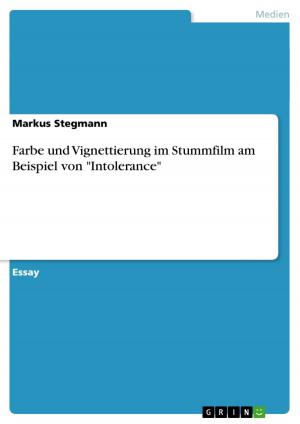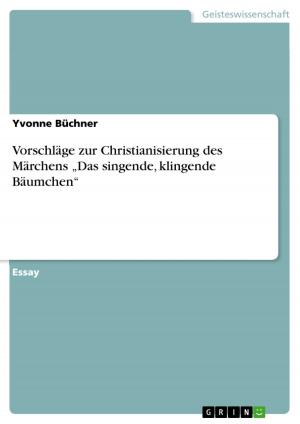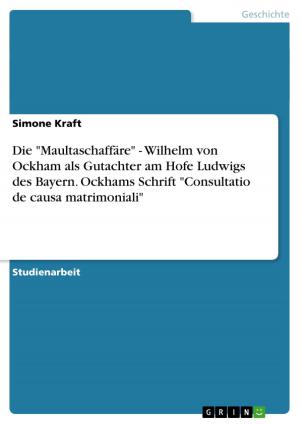The 'Fair Youth' and the 'Dark Lady' in Shakespeare's sonnets and their relationship to the Poetic Persona
Fiction & Literature, Literary Theory & Criticism, British| Author: | Eva Schiffbauer | ISBN: | 9783668264274 |
| Publisher: | GRIN Verlag | Publication: | July 20, 2016 |
| Imprint: | GRIN Verlag | Language: | English |
| Author: | Eva Schiffbauer |
| ISBN: | 9783668264274 |
| Publisher: | GRIN Verlag |
| Publication: | July 20, 2016 |
| Imprint: | GRIN Verlag |
| Language: | English |
Seminar paper from the year 2016 in the subject English Language and Literature Studies - Literature, grade: 2,0, RWTH Aachen University (Institut für Anglistik, Amerikanistik und Romanistik der RWTH Aachen), course: The Sonnet - History of a Genre, language: English, abstract: Nowadays sonnets, or probably even lyric in general, are not very popular anymore. That was quite different in the Elizabethan era when sonnet-writing was widespread during the so called 'sonnet vogue' at the end of the 16th century. A lot of sonnets were written during that time by poets like Sir Philip Sidney, Edmund Spenser or of course William Shakespeare, whose sonnet sequence contains 154 sonnets in total. Some of Shakespeare's sonnets are still very well-known today and are read and analysed by students in schools or universities. To get a better understanding of these poems, an important aspect one should be concerned with is the addressee of each sonnet. Shakespeare had two major addressees for his sonnets: The 'Fair Youth' - respectively the 'Young Man' - and the 'Dark Lady' whose identities are still a matter of speculation even today. The first part of Shakespeare's sonnet sequence, namely sonnets 1-126, is directed to the 'Young Man', while sonnets 127-154 are written to the 'Dark Lady'. But how are these figures - the young man and the dark lady - portrayed by the poetic persona? What does this portrayal tell the reader about the relationship between persona and addressee? Are these relationships of a similar nature or do they differ in some aspects? In this paper I am first going to deal with the 'Fair Youth' sequence: There will be a short characterisation of this figure before I will concern myself with the relationship to the poetic persona. After a brief summary of these results the 'Dark Lady' sonnets will be examined in the same manner while regarding the results about the 'Young Man' I achieved before. These points will be executed by looking at several sonnets in detail. For the 'Fair Youth' section these are going to be sonnets 18, 20, 26, and 116; for the 'Dark Lady' sonnets I will deal with sonnets 127, 130, 129, and 144. At the end I will recapitulate the ascertained outcomes in a conclusion.
Seminar paper from the year 2016 in the subject English Language and Literature Studies - Literature, grade: 2,0, RWTH Aachen University (Institut für Anglistik, Amerikanistik und Romanistik der RWTH Aachen), course: The Sonnet - History of a Genre, language: English, abstract: Nowadays sonnets, or probably even lyric in general, are not very popular anymore. That was quite different in the Elizabethan era when sonnet-writing was widespread during the so called 'sonnet vogue' at the end of the 16th century. A lot of sonnets were written during that time by poets like Sir Philip Sidney, Edmund Spenser or of course William Shakespeare, whose sonnet sequence contains 154 sonnets in total. Some of Shakespeare's sonnets are still very well-known today and are read and analysed by students in schools or universities. To get a better understanding of these poems, an important aspect one should be concerned with is the addressee of each sonnet. Shakespeare had two major addressees for his sonnets: The 'Fair Youth' - respectively the 'Young Man' - and the 'Dark Lady' whose identities are still a matter of speculation even today. The first part of Shakespeare's sonnet sequence, namely sonnets 1-126, is directed to the 'Young Man', while sonnets 127-154 are written to the 'Dark Lady'. But how are these figures - the young man and the dark lady - portrayed by the poetic persona? What does this portrayal tell the reader about the relationship between persona and addressee? Are these relationships of a similar nature or do they differ in some aspects? In this paper I am first going to deal with the 'Fair Youth' sequence: There will be a short characterisation of this figure before I will concern myself with the relationship to the poetic persona. After a brief summary of these results the 'Dark Lady' sonnets will be examined in the same manner while regarding the results about the 'Young Man' I achieved before. These points will be executed by looking at several sonnets in detail. For the 'Fair Youth' section these are going to be sonnets 18, 20, 26, and 116; for the 'Dark Lady' sonnets I will deal with sonnets 127, 130, 129, and 144. At the end I will recapitulate the ascertained outcomes in a conclusion.















